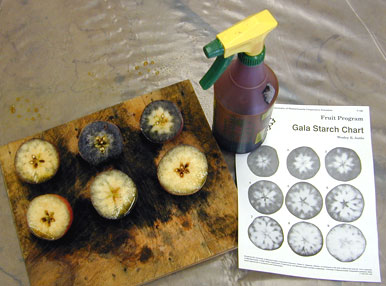 |
Painless and Efficient Maturity TestingWin Cowgill, County Agricultural Agent, Rutgers Cooperative ExtensionJon Clements, Extension Tree Fruit Specialist, University of MassachusettsJeremy Compton, North Jersey Tree Fruit Technician, Rutgers University |
|
Our observation has been that few growers utilize the Starch Index (SI) method of determining harvest maturity. Perhaps SI testing is perceived as time consuming and difficult to properly judge. We contend, however, that SI testing is the best and easiest indicator of apple maturity that a grower can use to plan their harvest and storage regimes. Why is it important to perform SI testing? First, as mentioned, the SI method is probably the best way to judge fruit maturity without expensive equipment. The Sl technique, wherein the starch to sugar ratio is measured, is correlated with ethylene evolution. In fact, ethylene synthesis occurs as fruit ripens. Therefore, the SI index is an inexpensive way to assess the degree to which fruit has converted starch to sugar, and is indicative of the onset and progress of ethylene production. Secondly, because SI is a reliable indicator of relative fruit maturity, SI testing can help you determine if harvested fruit should be placed in early CA, late CA, or regular cold storage. Remember that, as a rule, fruit with SI readings of 3-4 are suitable for late CA, apples measuring 4-6 on the SI scale are best for early CA, and any fruit reading 6 or above should be placed in regular cold storage or marketed immediately. Of course, reliability in using the SI method for determining apple maturity is predicated on good sampling techniques, i.e.; looking at fruit that has sufficient size and color. Or, in other words, sample apples that you expect are approaching harvest readiness. (Note: Apples going into late CA (available in April-June, etc.) should not average less than 15 lbs. flesh firmness.) |
 |
Dr. George Green, Pennsylvania State University, has more details on harvest maturity in the Pennsylavania Tree Fruit Production Guide. He also offers the following" "Over the years charts have been developed for many varieties but some charts went from 1 to 5 while others went from 1 to 7.There was much confusion so the postharvest physiologists at Cornell University have developed a more universally accepted chart that is useful for all varieties. It is being used by researchers in over 20 states in the national apple cultivar-testing program. Cornell has an excellent publication available to help you use the starch-iodine test and to develop an apple maturity program. The publication also contains a laminated starch iodine chart to aid in interpreting the tests. I strongly suggest that anyone seriously interested in harvesting high quality apples with good storage potential download a copy of this publication, 'Predicting Harvest Date Windows for Apples (1992)' Information Bulletin 221." Full-color plates show how to use and interpret the starch-iodine test for determining maturity and the best harvest dates for quality, especially important for apples going into storage. Covers McIntosh, Cortland, Empire, Delicious, Mutsu/Crispin, and Idared; dates for other varieties can be interpreted from the information presented. 20 pages. Cost $5.50 This publication can be ordered from Cornell University by calling 607-255-2080 and using a Master Card or VISA credit card to pay for the pub.
Specific starch charts have also been developed for Gala, Liberty, Cortland, and Mutsu. On the West Coast they have also been developed for Fuji.
Having tested tens of thousands of apples over the years, per numerous experimental protocols, we can now suggest a simple, quick and efficient method for evaluating orchard by orchard or block by block SI apple samples. Here is our quick and simple testing technique:
